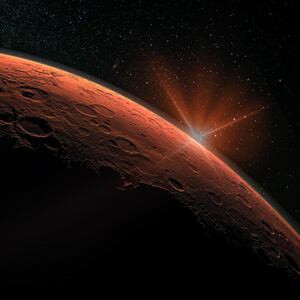A team of European scientists took charge of a powerful telescope in Chile, pointed its arrays at some baby stars quadrillions of miles away and, to their delight, detected signs of some very interesting chemical compounds swirling in the cosmic dust and gas.
It took two years for the scientists to comb through the data, and published the results. Turns out, the compounds—methyl isocyanate and glycolonitrile—are possible raw materials for the evolution of life. Scientists call them “prebiotics.”
But don’t kid yourself. There’s a lot of work left to do before we can say for sure where we came from, and how other species might evolve on the universe’s countless other habitable planets.
Space surveys previously found prebiotics in meteorites as well as in the nearly-imperceptibly thin dust that stretches between stars. But finding them in the vast swirl around a pair of still-forming “proto-stars”—the universe’s furnaces of creation—could bring us a step closer to understanding where life comes from and how it might spread across the universe.
The eight-scientist team led by Niels Ligterink, a physicist at the University of Bern in Switzerland, published its findings in the online science journal arXiv on Dec. 31. The journal Astronomy and Astrophysics has also accepted the study for publication.
“The new detections of CH3NCO and HOCH2CN are additional evidence for a large interstellar reservoir of prebiotic molecules that can contribute to the formation of biomolecules on terrestrial planets,” the scientists wrote.
Emphasis on can. The chemicals the Europeans detected are, at best, an evolutionary starting point. “What we fundamentally don't know is how we get from those to life,” Martin Dominik, an astronomer at the University of St Andrews in the United Kingdom, told The Daily Beast.
In March 2019, Ligterink’s squad commandeered the Atacama Large Millimeter Array, a suite of 66 individual telescopes spread across a high-altitude desert in Chile.
Hoping for evidence of prebiotics, they pointed the instruments at Serpens SMM1-a, a far-away proto-star that’s slowly forming inside a cloud of dust and gas. The same team also sifted through existing Atacama survey data from another proto-star, IRAS 16293B.
Different chemicals emit different patterns of electromagnetic energy—“spectral fingerprints,” Ligterink called them. These fingerprints are clues scientists here on Earth read to determine the composition of planets and stars impossibly distant from our own.
Prebiotics help to form the peptide structures that in turn form proteins, which themselves do much of the work inside living cells.
If prebiotics are present in the formation of a star and, by extension, that star’s planets, they could help to explain how life has evolved on at least one of the universe’s roughly 700 quintillion planets—our own.
They might also help to explain how life could eventually evolve on other planets.
“We think that life on planets like Earth emerged from a so-called prebiotic soup—basically a natural chemical reactor—in which a large diversity of molecules came together to start biochemical reactions and eventually form the first simple organism,” Ligterink told The Daily Beast.
“If many other star-forming regions are so rich in prebiotic molecules, it makes it likely that this scenario occurs on many other planets,” Ligterink added, “increasing the likelihood for life to emerge on other planets and thus the likelihood to find it!”
To be clear, the team expected to detect the prebiotic methyl isocyanate, a caustic chemical that’s present in pesticides and adhesives. Sure enough, there it was, floating in the celestial eddies around Serpens SMM1-a and IRAS 16293B.
But there was also a surprise in the data. The prebiotic glycolonitrile was there, too. Scientists have only ever detected that chemical once before in space surveys. “Therefore, it really is the highlight of our observational program,” Ligterink said.
Ligterink’s team’s first-ever discovery of both methyl isocyanate and glycolonitrile around young proto-stars inches us toward a more complete understanding of where life comes from. But it’s clear we’re missing big pieces of the puzzle.
“There are, of course, other conditions necessary for life to appear, but we know at least that some key ingredients are available,” Audrey Coutens, an astrophysicist at the University of Bordeaux in France and a member of Ligterink’s team, told The Daily Beast.
“For now the interaction between star formation and prebiotic molecules is still a bit of a mystery,” Ligterink said. “For sure, prebiotics form during star formation and chemical reactions are influenced by star formation, but in what way we don't know yet.”
Indeed, there’s a heated debate in scientific circles over just how big the evolutionary puzzle is—and how much more we need to learn before we can say for sure how we got here and whether we’re likely to be alone in the universe.
“At this point, we have no direct link between these molecules floating in space and any lifeforms in the vicinity of their protostars,” Douglas Vakoch, president of the San Francisco science-advocacy group Messaging Extraterrestrial Intelligence, told The Daily Beast. “In fact, we’re still waiting to detect the first extraterrestrial microbe anywhere.”
“I don’t see the big deal in finding bio-organics in space, either near or far from celestial objects,” Gilbert Levin, a former NASA scientist who helped to lead an early search for life on Mars, told The Daily Beast. “None of that gets us any closer to how did life originate. How [do you] cross the line from inanimate to living?”
But Vakoch defended Ligterink’s team’s work. Sure, they didn’t rewrite cosmic history when they found interesting chemicals spinning around a pair of infant stars. But then, no one ever solves a mystery as big as the origin of life with a single study.
“Scientific progress is cumulative,” Vakoch said. “Molecule by molecule, we’re coming to an increasingly comprehensive understanding of the nature and composition of the universe. You don’t have to win a Nobel Prize to make an important contribution as an astronomer.”
And more discoveries undoubtedly are coming. The Atacama Large Millimeter Array in Chile is a great instrument for surveying distant stars. But even better ones are coming.
NASA has penciled in the powerful James Webb Space Telescope for an October launch. And the equally sophisticated European Space Agency’s Atmospheric Remote-sensing Infrared Exoplanet Large-survey satellite, or ARIEL, is due to boost into space in 2029.







